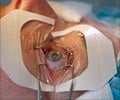
Presently, James can see a rough outline of simple shapes but the doctors believe that in time - as his brain 'learns' to see again - he could recognise faces.
"I've always had that thought that one day I would be able to see again," Professor Robert MacLaren said.
"This is not a cure, but it may put the world into some perspective.
"It'll give me some imagery rather than just a black world."
Surgeons at Oxford's John Radcliffe Hospital and King's College Hospital in London are testing the implant in a clinical trial of up to 12 patients with retinitis pigmentosa.
Advertisement
Approximately 25,000 families in Britain are affected by the condition, for which there is no treatment.
Advertisement
Professor Robert MacLaren, professor of ophthalmology at the University of Oxford, insisted that the success of surgery was a "great relief".
"Chris is doing extremely well," he said.
"With the first operation, with the new technology and the complexity of everything, we are all absolutely delighted with the result."
A second patient has since been fitted with the chip and even he is responding well.
The sensor, designed by the company Retina Implant, is only 3mm square and packed with 1,500 pixels.
Light falling on the pixels is converted into an electrical signal that is picked up by nerves and transmitted to the visual processing region of the brain.
Patients are able to see a grainy, black and white image.
And since the chip just covers a small part of the retina, their field of view is limited to a window the size of a CD case held at arm's length.
However, because James has been blind for so long, his brain will take weeks to make sense of the images.
Although he can see the curve of a plate, he does not make out the whole circle.
"The image is fragmented," Professor MacLaren said.
"A circle may be perceived as two half circles, or even four quadrants, perhaps in different parts of space. What the brain needs to learn to do is put that back into one single object.
"It is repeating in many ways what we all did when we learned to see in early childhood," Professor MacLaren added.
Professor MacLaren asserted that future generations of the chip are likely to be bigger, to widen the field of view, and have greater resolution.
The technology also shows promise to restore sight in patients with macular degeneration, a common disease in the over-65s.
Source-ANI












